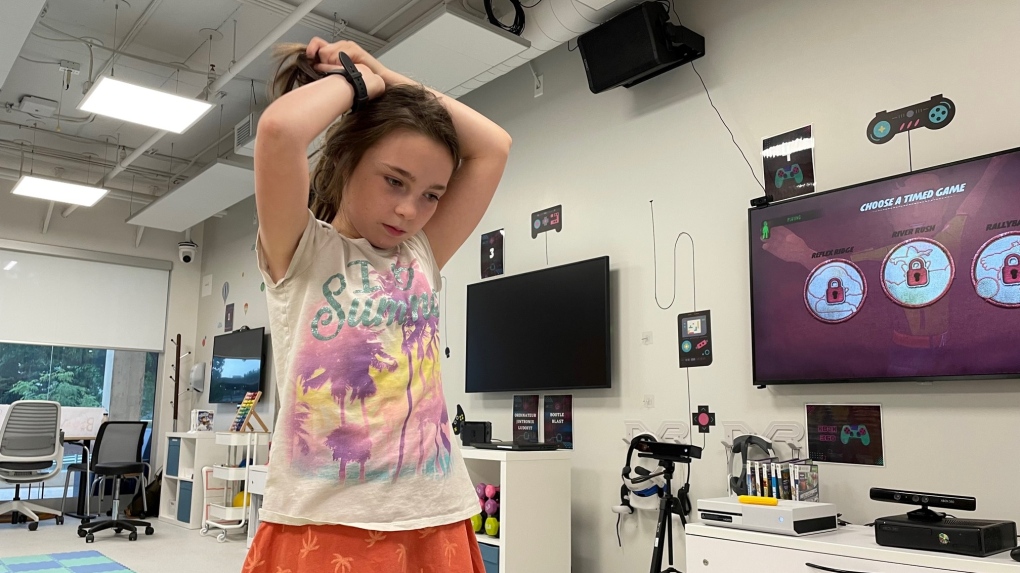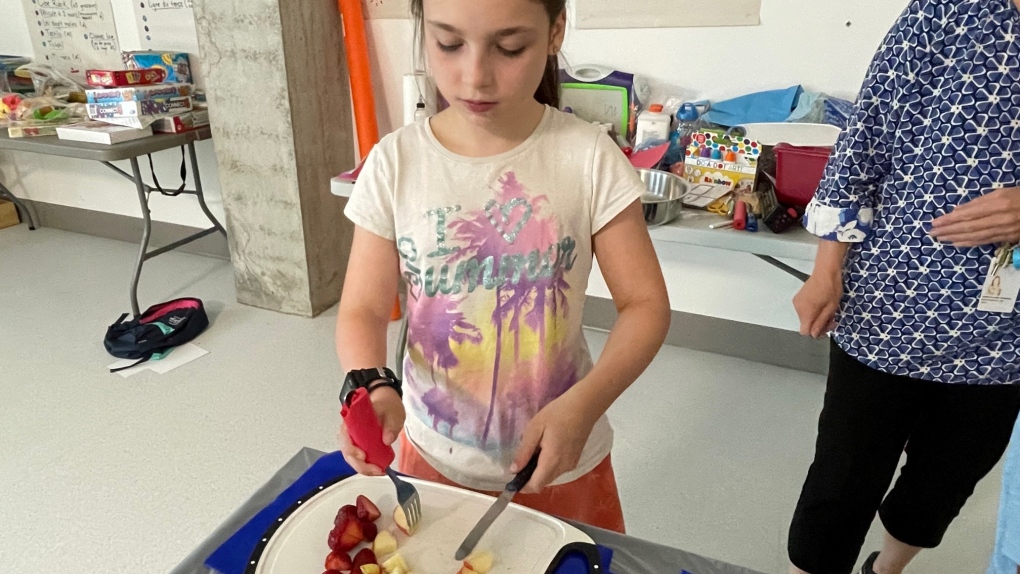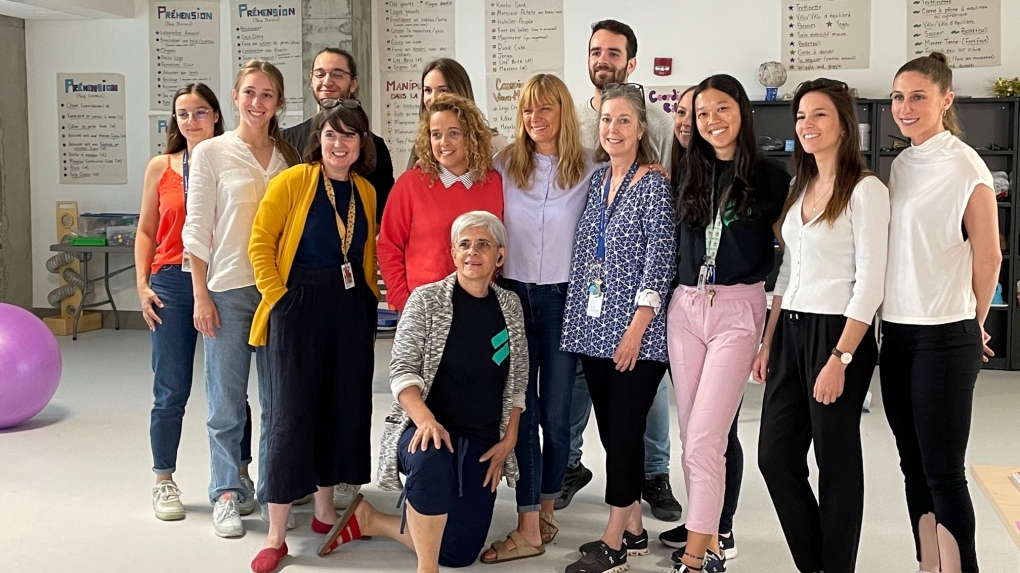Summer camp run by Sainte-Justine Hospital puts the fun in function for kids
There's a summer camp in Montreal that offers its young charges a lot more than just a slew of fun activities.
The children who attend a two-week session coordinated by Centre de réadaptation Marie Enfant, a part of Sainte-Justine Hospital (SJH) also return home at the end of each day with gradually improving motor skills, coordination and balance, and a newfound sense of pride.
The camp, located at the rehabilitation centre on Belanger Street, is designed to support a small group of children who have a condition called hemiplegia.
"Basically, the part of the brain that controls movement, sensation in one half of the body has been damaged usually at or near birth by a lack of oxygen to the developing brain," explained Danielle Levac, associate professor of physiotherapy at Université de Montréal and a researcher at SJH.
As a result, the children have a problem with motor control and coordination.
"It's very difficult for them to use that side of the body accurately and precisely and they tend to not want to use it for that reason," Levac explained.
 Olivia Bélanger, 10, practices the physical and occupational therapy techniques she’s received at Camp HABIT-ILE to help her be able to make a ponytail on her own.
Olivia Bélanger, 10, practices the physical and occupational therapy techniques she’s received at Camp HABIT-ILE to help her be able to make a ponytail on her own.
The less used side of the body gets weaker. Hands can stiffen and be hard to open and close.
Everyday life is affected.
"When you think about it, most activities of daily life require the use of two hands: buttoning up your sweaters, zipping up a zipper, reaching for an object. And it's not just the hands, it's the full body," she said.
The condition affects the trunk of the body, balance and walking, and gross motor activities like jumping and skipping rope with their friends in the playground.
FIVE FUNCTIONAL GOALS
To improve their mobility, the children are asked to come to camp with five functional goals in mind, such as wanting to be able to ride a bicycle, make their ponytail or use a knife and fork better.
 Olivia Bélanger practices using her weaker right hand along with her left, to use a knife and fork together.
Olivia Bélanger practices using her weaker right hand along with her left, to use a knife and fork together.
Then the team of physiotherapists, occupational therapists and educators work to create an individualized plan for each child.
"We analyze these goals and we see the skills that are necessary to attain those goals," said physiotherapist Odette Bau.
"They do a lot of activities, they have fun, but at the same time, they work. It's a lot of effort," Bau said.
Levac said the program's intensity is the key ingredient -- the intensity of effort makes a difference.
"They're getting a lot of repetitions of these functional movements that they wouldn't normally otherwise."
"When they're here with us all day for two weeks, we're able to really get that dosage and that's what's going to cause those practice-based changes in the brain, the neuroplastic changes that are going to help them improve," Levac said.
 Camp HABIT-IL staff gather for a group photo at Centre de réadaptation Marie-Enfant. (Cindy Sherwin/CTV News)
Camp HABIT-IL staff gather for a group photo at Centre de réadaptation Marie-Enfant. (Cindy Sherwin/CTV News)
One of the campers, 10-year-old Olivia Bélanger, has been playing a lot of video and virtual reality games to coax the right side of her body to become more agile and strong.
Part of Levac's research, now in its second year at the camp, is testing whether new technologies like virtual reality are beneficial tools to add to the therapeutic mix.
One of Bélanger's personal goals is to be able to clasp her long, light brown hair beyond her head by herself and wrap it up with a tight elastic to create a ponytail, like so many other children do every day.
She succeeded. "Yes, it's a little bit difficult, but I'm proud," she said, giving the admiring crowd of therapists around her a big thumbs-up and an ear-to-ear smile.
"It's very impressive how some of the kids have reached new goals," said Marie-Claude Cardinal, an occupational therapist at the camp.
Cardinal points out that the camp is invaluable because the children are in the regular school system and don't have access to or the time for intensive physical therapy during the school year.
At camp, they receive 50 to 60 hours of therapy in two weeks. There's also a social benefit.
"The camp provides them with the opportunity to be with other kids with the same diagnosis," said Cardinal.
A BELGIAN MODEL
The official name of the camp, when broken down, explains its overall concept. It's called HABIT-ILE.
That stands for hand and arm bimanual intensive therapy, including lower extremities.
"It's an approach to therapy that was developed in Belgium and is now implemented all over the world, and it's delivered in a summer camp model," said Levac.
It's been operated in Montreal for about 15 years.
And the children do take home what they learn. The daily practical movement techniques the children repeat in the camp can be replicated and practiced with their families.
"When you see the parent watch their child do something that previously was difficult or that the child needed a lot of help with, you know that you've really made a difference in the life of that child," said Levac.
CTVNews.ca Top Stories

Can the Governor General do what Pierre Poilievre is asking? This expert says no
A historically difficult week for Prime Minister Justin Trudeau and his Liberal government ended with a renewed push from Conservative Leader Pierre Poilievre to topple this government – this time in the form a letter to the Governor General.
Two U.S. Navy pilots shot down over Red Sea in apparent 'friendly fire' incident, U.S. military says
Two U.S. Navy pilots were shot down Sunday over the Red Sea in an apparent 'friendly fire' incident, the U.S military said, marking the most serious incident to threaten troops in over a year of America targeting Yemen's Houthi rebels.
Ottawa MP Mona Fortier appointed chief government whip
Ottawa-Vanier MP Mona Fortier has been appointed as chief government whip, the latest addition in a major reshuffle of Prime Minister Justin Trudeau's cabinet.
opinion Tom Mulcair: Prime Minister Justin Trudeau's train wreck of a final act
In his latest column for CTVNews.ca, former NDP leader and political analyst Tom Mulcair puts a spotlight on the 'spectacular failure' of Prime Minister Justin Trudeau's final act on the political stage.
B.C. mayor gets calls from across Canada about 'crazy' plan to recruit doctors
A British Columbia community's "out-of-the-box" plan to ease its family doctor shortage by hiring physicians as city employees is sparking interest from across Canada, says Colwood Mayor Doug Kobayashi.
Bluesky finds with growth comes growing pains - and bots
Bluesky has seen its user base soar since the U.S. presidential election, boosted by people seeking refuge from Elon Musk's X, which they view as increasingly leaning too far to the right given its owner's support of U.S. president-elect Donald Trump, or wanting an alternative to Meta's Threads and its algorithms.
'There’s no support': Domestic abuse survivor shares difficulties leaving her relationship
An Edmonton woman who tried to flee an abusive relationship ended up back where she started in part due to a lack of shelter space.
opinion King Charles' Christmas: Who's in and who's out this year?
Christmas 2024 is set to be a Christmas like no other for the Royal Family, says royal commentator Afua Hagan. King Charles III has initiated the most important and significant transformation of royal Christmas celebrations in decades.
OPP find wanted man by chance in eastern Ontario home, seize $50K worth of drugs
A wanted eastern Ontario man was found with $50,000 worth of drugs and cash on him in a home in Bancroft, Ont. on Friday morning, according to the Ontario Provincial Police (OPP).


































